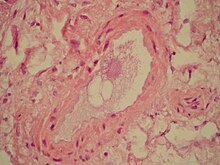Fat embolism

| Classification according to ICD-10 | |
|---|---|
| T79 | Certain early complications of trauma, not elsewhere classified |
| T79.1 | Fat embolism (traumatic) |
| O88 | Embolism during the gestational period |
| O88.2 | Embolism after abortion, ectopic and molar pregnancy |
| O88.8 | Other embolism during the gestational period - fat embolism during the gestational period |
| ICD-10 online (WHO version 2019) | |
A fat embolism is an embolism caused by fat droplets appearing in the bloodstream . These occur either as released tissue fats and / or as precipitated plasma fats , for example after a bone fracture with bone marrow involvement , during major orthopedic interventions such as the implantation of endoprostheses on large joints , amputations , soft tissue crushing , burns , high voltage injuries or the injection of oily preparations into the bloodstream.
Clinical picture
The clinical picture corresponds to that of an acute pulmonary embolism with respiratory insufficiency , right heart failure and cardiac arrhythmia up to acute cardiovascular arrest that can occur seconds to minutes after the damaging event. Delayed (within 36-72h) there may be dot-shaped Hauteinblutungen ( petechiae ), coagulation disorders up to the coagulation by cerebral and impaired consciousness Mikroinfarzierung come. This clinical picture is known as fat embolism syndrome.
Pathogenesis
The main cause of acute fat embolism is assumed to be an increase in pressure in the medullary canal with the passage of fat and bone marrow cells into the bloodstream. This leads to a microembolization of the small pulmonary vessels with an increase in pressure in the pulmonary circulation. The breakdown of the fat particles in the pulmonary capillaries into toxic fatty acids is assumed to be the cause of the fat embolism syndrome. These pathomechanisms could be confirmed in animal experiments.
therapy
The therapy initially consists of a generous supply of oxygen and careful volume replacement under control of the pulmonary arterial pressure ( right heart catheter ), catecholamines and, if necessary, resuscitation . The usual intensive care therapy follows.
The fat embolism syndrome is essentially treated symptomatically (correction of the coagulation disorder, fluid balance and safeguarding of kidney function).
Fat embolism as a complication of orthopedic / trauma surgery operations
Fat embolism occurs in trauma surgery and orthopedic operations, but is common in comparison to all other causes. This applies in particular to intramedullary nailing , the implantation of endoprostheses of the hip or knee joint and vertebroplasty . The critical point here is driving the intramedullary nail or the prosthesis shaft component into the medullary canal of the femur (thigh bone). The main cause is assumed to be the increased pressure on the bone marrow, plus the heating in the setting phase of the bone cement and possibly a transfer of ingredients of the bone cement ( methacrylic acid methyl ester ) into the bloodstream.
The frequency ( incidence ) of fat embolisms after hip prosthesis implantation is given as 0.6% –10%, the fatal outcome ( lethality ) as 0.2% –0.6%.
A whole series of different measures has been proposed for the prophylaxis of fat embolism (washing out of the medullary canal, relief drilling, vacuum cementation, blood lock and others). Due to a lack of evidence , none of these measures has prevailed so far .
swell
- N. Aebli, R. Pitto, J. Cancer: fat embolism - a potentially fatal complication during orthopedic surgery. In: Switzerland Med Forum. 2005; 5, pp. 512-518. (PDF)